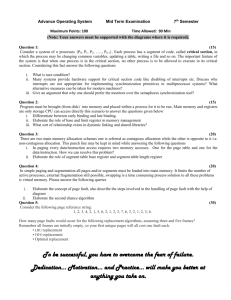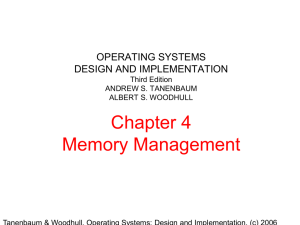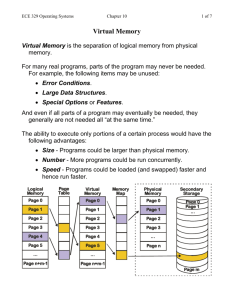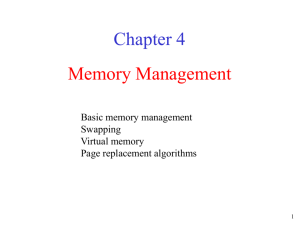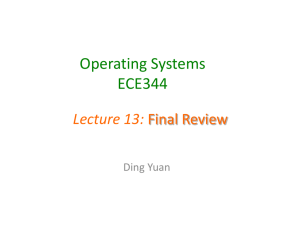Memory Management
advertisement
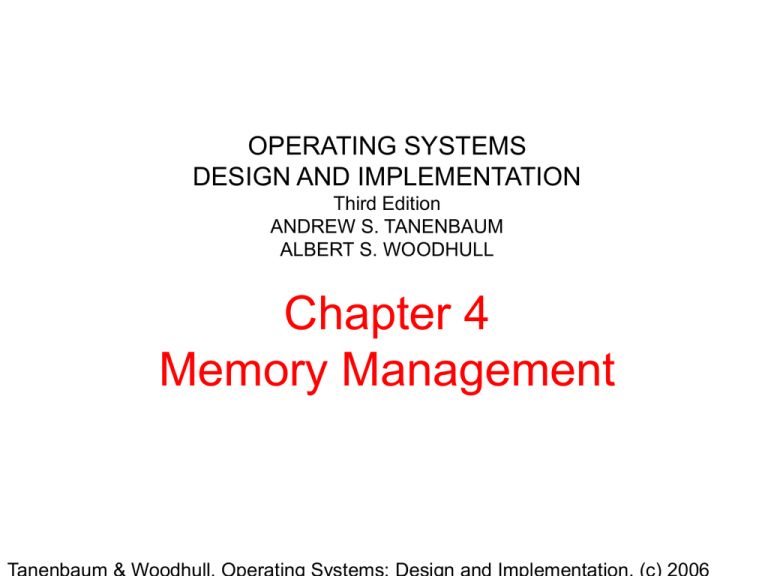
OPERATING SYSTEMS DESIGN AND IMPLEMENTATION Third Edition ANDREW S. TANENBAUM ALBERT S. WOODHULL Chapter 4 Memory Management Monoprogramming without Swapping or Paging Figure 4-1. Three simple ways of organizing memory with an operating system and one user process. Other possibilities also exist. Memory Management Monoprogramming – – Simple allocation – give process all available memory! Protect OS from user process (esp. in batch systems) Multiprogramming – – – Allocation more challenging – multiple processes come and go; how to find a place for a process? Do small processes have to wait for large process that arrived first to find a hole? If not, does large process starve? Protect OS and other processes from each user process Monoprogramming Memory Protection Physical Address YES Fence Register <? Trap – illegal address NO Put PA on system bus Fence Register set by OS (option (a)), never changed Every physical address generated in user mode tested against FR – protect the OS (req. batch systems) Test done in hardware – done on every memory access Multiprogramming with Fixed Partitions (1) Figure 4-2. (a) Fixed memory partitions with separate input queues for each partition. Multiprogramming with Fixed Partitions (2) Figure 4-2. (b) Fixed memory partitions with a single input queue. Multiprogramming Memory Protection Physical Address YES High Register >? Trap – illegal address NO YES Low Register <? Trap – illegal address NO Put PA on system bus High and Low Registers set by OS on context switch Every (physical) address generated in user mode tested against these (depends on allocation/partition) – in H/W Memory Binding Time At coding – Assembler can use absolute addresses At compile time – – Compiler resolves locations to absolute addresses May be informed by OS automatically At load time – – Scheduler can fix addresses Possible to swap out, then back in to relocate process At run time – – – Process only generates logical addresses OS can relocate processes dynamically Much more flexible Multiprogramming Limit-Base Memory Protection Logical Address YES Limit Register >? Trap – illegal address Add Put PA on system bus NO Base Register Base and Limit Registers set by OS on context switch Every logical address generated in user mode tested against limit (depends on allocation/partition) If not too large, added to Base Register value to make PA Test and manipulations all done in hardware Multiprogramming Memory Protection (2) Proc B Base Register B Proc A Base Register A OS Each process has its own Base and Limit Registers set by OS on context switch Swapping (1) Figure 4-3. Memory allocation changes as processes come into memory and leave it. The shaded regions are unused memory. Swapping (1) B C C C C B B B B C A A OS A OS A OS A OS D D D OS OS OS Figure 4-3. Memory allocation changes as processes come into memory and leave it. The shaded regions are unused memory. Swapping (2) Figure 4-4. (a) Allocating space for a growing data segment. Swapping (3) Figure 4-4. (b) Allocating space for a growing stack and a growing data segment. Memory Management with Bitmaps Figure 4-5. (a) A part of memory with five processes and three holes. The tick marks show the memory allocation units. The shaded regions (0 in the bitmap) are free. (b) The corresponding bitmap. (c) The same information as a list. Memory Management with Linked Lists Figure 4-6. Four neighbor combinations for the terminating process, X. Memory Allocation Algorithms • • • • • First fit Use first hole big enough Next fit Use next hole big enough Best fit Search list for smallest hole big enough Worst fit Search list for largest hole available Quick fit Separate lists of commonly requested sizes Memory Waste Fragmentation • Internal – memory allocated to a process that it does not use – Allocation granularity – Room to grow • External – memory not allocated to any process but too small to use (checkerboarding) – Dynamic vs. fixed memory partitions – Compaction (like defragmentation) – Paging Paging (1) Figure 4-7. The position and function of the MMU. Here the MMU is shown as being a part of the CPU chip because it commonly is nowadays. However, logically it could be a separate chip and was in years gone by. Paging (2) Figure 4-8. The relation between virtual addresses and physical memory addresses is given by the page table. Paging (3) Figure 4-9. The internal operation of the MMU with 16 4-KB pages. Page Tables • Purpose: map virtual pages onto page frames (physical memory) • Major issues to be faced 1. The page table can be extremely large 2. The mapping must be fast. Multilevel Page Tables Figure 4-10. (a) A 32-bit address with two page table fields. (b) Two-level page tables. Structure of a Page Table Entry Figure 4-11. A typical page table entry. Memory Hierarchy (1) Memory exists at multiple levels in a computer: Registers (very few, very fast, very expensive) L1 Cache (small, fast, expensive) L2 Cache (modest, fairly fast, fairly expensive) Maybe L3 Cache (usu. combined with L2 now) RAM (large, somewhat fast, cheap) Disk (huge, slow, really cheap) Archival storage (tape, DVD, CD-ROM, etc.) (massive, ridiculously slow, ridiculously cheap) A “hit” at one level means no need to access lower level (at least for a read) Memory Hierarchy (2) Registers - tiny L1 – small (32KB-128KB) L2/L3 – modest (128KB-2M) RAM – big (256MB-8GB+) Disk – huge (80GB-1TB+) motherboard In CPU In CPU Reg CPU L1 VERY FAST expensive In/near CPU on Motherboard L2/L3 PRETTY FAST RAM Disk Ctlr Disk Across bus Via bus and controller cheap SLOW Really cheap Memory Hierarchy (3) Cache saves access time and use of bus: Cache hit allows DMA to use bus for xfers Effective Memory Access Time (EAT) is weighted sum: (prob hit)(hit time)+(prob miss)(miss time) Memory Hierarchy (3.5) Cache saves access time and use of bus: Big issue: what is cache line size? Big issue: cache replacement policy Trade off hit rate due to #lines = cache size/line size Locality of reference (spatial and temporal) Which line to replace when miss and cache full? Big issue: cache consistency Write-through or write-back (lazy writes)? Access by other CPU, peripheral - coherence? Memory Hierarchy (4) Various types of cache common on modern processors: Instruction cache – frequently used memory lines of text segment(s) (may be combined with data) Data cache – recently/frequently used lines of data and/or stack segments Translation Lookaside Buffer (TLB) – popular page table entries Standard cache uses cache lines of 32-256 bytes each, TLB uses page table entries (usu. 4 bytes) All use associative (content-addressable) memory Tag is the part of cache line that is used to address it TLBs—Translation Lookaside Buffers Figure 4-12. A TLB to speed up paging. TLB Operation Restart instruction on resume CPU CPU generates virtual address Cache/HW VA TLB MMU VP RAM PT in RAM Disk PT on Disk PA Page in RAM Page on Disk TLB hit? no yes Physical Addr MMU accesses PT in RAM (add VP number x entry size to PT Base register value) Page in RAM? yes Load TLB no Page Fault – bring in page, update PT Inverted Page Tables How big is it? 4 B/entry x 252 = 256Bytes Won't fit in 228Byte memory! Software version of TLB – bigger and slower If PT miss, then must bring in/make PT entry! Figure 4-13. Comparison of a traditional page table with an inverted page table in a 64-bit address space. Page Replacement Algorithms What is optimal page to replace? • • • • • • • Page not used again for longest tim Optimal replacement Not recently used (NRU) replacement First-in, first-out (FIFO) replacement Second chance replacement Clock page replacement Least recently used (LRU) replacement Not Frequently Used (NFU) replacement Reduced Reference String • Trace of process execution gives string of referenced logical addresses • Address trace yields reference string of corresponding pages • But multiple addresses are on the same page, so reference string may have many consecutive duplicate pages • Consecutive references to the same page will not produce a page fault – redundant! • Reduced reference string eliminates consecutive duplicate page references • Page fault behavior is the same – unless algorithm works on clock ticks or actual number of references Reduced Reference String • Trace of referenced logical addresses • Reference string of corresponding pages • Reduced reference string Assuming 4 kB pages 0x82013 0x82014 0x03295 0x82015 0x82016 0x03295 0x82017 0x82 0x82 0x82 0x03 0x82 0x03 0x82 0x82 0x03 0x82 0x03 0x82 Optimal Page Replacement 3 Frames, Reduced Reference String: 012023104120303120210 Page Frame Contents Page Faults: 00000 1111 222 xxx 0000000 1111111 3334422 x x x 000000000 111111111 333322222 x x Total of 8 PFs LRU Page Replacement 3 Frames, Reduced Reference String: 012023104120303120210 01202 0120 011 xxx 31041 23104 02310 xxxx What do we have to work with? Recall typical page table entry: P bit (or V bit for valid) – page is in RAM (else page fault) M bit (dirty bit) – page in RAM has been modified R bit – page referenced since last time R was cleared NRU Page Replacement Reference bit set on load or on access Reference bit cleared on clock tick (for running process) On page fault, pick a page that has R=0 (only two groups) To improve performance, better to replace a page that has not been modified... So – set M bit on write, clear M bit when copied to disk Schedule background task to copy modified pages to disk Now 4 groups based on R & M: 11,10, 01, 00 On page fault, pick victim from lowest group Cheap & reasonably good algorithm Hey! How can this happen? NRU Page Replacement R set on load or on access, cleared on clock tick M set on write, cleared on copy to disk Access Page in On Write Page in On Read Copy to disk R=1,M=0 R=1,M=1 Write Write Clock tick Access R=0,M=1 Clock tick Copy to disk Read Read R=0,M=0 NRU Page Replacement Page: R set on load or on access, cleared on clock tick 1W 2W 4R Clock tick 2R Write 2 to disk Page1 is best candidate (0,1) 2 3 4 0R 3W Which page(s) might be replaced If a page fault occurred here? 1 RM RM RM RM RM M set on write, cleared on copy to disk Which page(s) might be replaced If a page fault occurred here? Page 3 is best candidate (0,0) 0 1W 4R 10 00 00 00 00 10 11 00 00 00 10 11 11 00 00 10 11 11 00 10 00 01 01 00 00 00 01 11 00 00 00 01 11 11 00 00 01 10 11 00 11 01 10 11 00 11 01 10 11 10 Second Chance Replacement Figure 4-14. Operation of second chance. (a) Pages sorted in FIFO order. (b) Page list if a page fault occurs at time 20 and A has its R bit set. Note that shuffle only occurs on a page fault, unlike LRU. The numbers above the pages are their (effective) loading times. Clock Page Replacement Figure 4-15. The clock page replacement algorithm. It is essentially the same as Second Chance (only use pointers to implement instead of shuffling) Simulating LRU in Software (1) Figure 4-16. LRU using a matrix when pages are referenced in the order 0, 1, 2, 3, 2, 1, 0, 3, 2, 3. Simulating LRU in Software (2) Figure 4-17. The aging algorithm simulates LRU in software. Shown are six pages for five clock ticks. The five clock ticks are represented by (a) to (e). (May also use M bit as tiebreaker.) Page Fault Frequency Figure 4-20. Page fault rate as a function of the number of page frames assigned. Stack Algorithms Belady's anomaly - a.k.a. FIFO anomaly – Belady noticed that when allocation increased, sometimes the page fault rate increased! Stack algorithms – never suffer from FIFO anomaly – Let P(s,i,a) be the set of pages in memory for reference string s after the ith element has been referenced when a frames are allocated. – A stack algorithm has the property that for any s, i, and a P(s,i,a) is a subset of P(s,i,a+1) – In other words, any page that is in memory with allocation a is also in memory with allocation a+1 The Working Set Model (1) k Figure 4-18. The working set is approximated by the set of pages used by the k most recent memory references. The function w(k, t) is the size of the (approx.) working set at time t. The Working Set Model (2) The working set (WS) is the set of pages “in use” We want the working set in RAM! But we don't really know what the working set is! And the WS changes over time – locality of reference in space and time (think about calling a subroutine or loops in code) It is usually approximated by the set of pages used by the k most recent memory references. The function w(k, t) is the size of the (approx.) working set at time t. Note that the previous graph only shows how w(k, t) changes for one locality (one WS) as all of its pages are eventually referenced Since WS changes over time, so does w(k,t) So should allocation to the process! Thrashing Thrashing is the condition that a process does not have sufficient allocation to hold its working set This leads to high paging frequency with short CPU bursts – – The symptom of thrashing is high I/O and low CPU utilization Can also detect via high Page Fault Frequency (PFF) The cure? Give the thrashing process(es) more memory – – Take it from another process Swap out one or more processes until the demand is lower (medium term scheduler/memory scheduler) PFF for Global Allocation Figure 4-20. Above A, process is thrashing, below B, it can probably give up some page frames without harm. Local versus Global Allocation Policies Figure 4-19. Local versus global page replacement. (a) Original configuration. (b) Local page replacement. (c) Global page replacement. Segmentation (1) Examples of tables saved by a compiler … 1. 2. 3. 4. 5. The source text being saved for the printed listing (on batch systems). The symbol table, containing the names and attributes of variables. The table containing all the integer and floating-point constants used. The parse tree, containing the syntactic analysis of the program. The stack used for procedure calls within the compiler. These will vary in size dynamically during the compile process Segmentation (2) Figure 4-21. In a one-dimensional address space with growing tables, one table may bump into another. Segmentation (3) Figure 4-22. A segmented memory allows each table to grow or shrink independently of the other tables. Segmentation (4) ... Figure 4-23. Comparison of paging and segmentation. Segmentation (4) ... Figure 4-23. Comparison of paging and segmentation. Implementation of Pure Segmentation Figure 4-24. (a)-(d) Development of checkerboarding. (e) Removal of the checkerboarding by compaction. (Much like defragging a disk, only in RAM) Segmentation with Paging: The Intel Pentium (0) Pentium supports up to 16K (total) segments of 232 bytes (4 GB) each Can be set to use only segmentation, only paging, or both Unix, Windows use pure paging (one 4GB segment) OS/2 used both Two descriptor tables – – – LDT (Local DT) – one per process (stack, data, local code) GDT (Global DT) – one for whole system, shared by all Each table holds 8K segment descriptors, each 8 bytes long Segmentation with Paging: The Intel Pentium (1) Figure 4-25. A Pentium selector. Pentium has 6 16-bit segment registers – – CS for code segment DS for data segment Segment register holds selector – – – Zero used to indicate unused SR, cause fault if used Indicates global or local DT, privilege level 3 LSBs are zeroed and added to DT base address to get entry Segmentation with Paging: The Intel Pentium (2) Figure 4-26. Pentium code segment descriptor. Data segments differ slightly. Segmentation Address Translation Physical Memory Segment Table Valid Z Limit Z Base Z Segt C ... Valid C Limit C Base C Valid B Limit B Base B Valid A Limit A Segt A Base A OS Each process has its own Base and Limit Registers set by OS on context switch used to translate virtual address of (segment, offset) to physical address Segmentation with Paging: The Intel Pentium (3) Figure 4-27. Conversion of a (selector, offset) pair to a linear address. Segmentation with Paging: The Intel Pentium (4) Figure 4-28. Mapping of a linear address onto a physical address. Segmentation with Paging: The Intel Pentium (6) Figure 4-29. Protection on the Pentium. Privilege state (changed when calls are made) compared to descriptor protection bits. Memory Layout (1) Figure 4-30. Memory allocation (a) Originally. (b) After a fork. (c) After the child does an exec. The shaded regions are unused memory. The process is a common I&D one. Memory Layout (2) Figure 4-31. (a) A program as stored in a disk file. (b) Internal memory layout for a single process. In both parts of the figure the lowest disk or memory address is at the bottom and the highest address is at the top. Process Manager Data Structures and Algorithms (1) Figure 4-32. The message types, input parameters, and reply values used for communicating with the PM. Process Manager Data Structures and Algorithms (2) ... Figure 4-32. The message types, input parameters, and reply values used for communicating with the PM. Processes in Memory (1) Figure 4-33. (a) A process in memory. (b) Its memory representation for combined I and D space. (c) Its memory representation for separate I and D space Processes in Memory (2) Figure 4-34. (a) The memory map of a separate I and D space process, as in the previous figure. (b) The layout in memory after a second process starts, executing the same program image with shared text. (c) The memory map of the second process. The Hole List Figure 4-35. The hole list is an array of struct hole. FORK System Call Figure 4-36. The steps required to carry out the fork system call. EXEC System Call (1) Figure 4-37. The steps required to carry out the exec system call. EXEC System Call (2) Figure 4-38. (a) The arrays passed to execve. (b) The stack built by execve. (c) The stack after relocation by the PM. (d) The stack as it appears to main at start of execution. EXEC System Call (3) Figure 4-39. The key part of crtso, the C run-time, start-off routine. Signal Handling (1) Figure 4-40. Three phases of dealing with signals. Signal Handling (2) Figure 4-41. The sigaction structure. Signal Handling (3) Figure 4-42. Signals defined by POSIX and MINIX 3. Signals indicated by (*) depend on hardware support. Signals marked (M) not defined by POSIX, but are defined by MINIX 3 for compatibility with older programs. Signals kernel are MINIX 3 specific signals generated by the kernel, and used to inform system processes about system events. Several obsolete names and synonyms are not listed here. Signal Handling (4) Figure 4-42. Signals defined by POSIX and MINIX 3. Signals indicated by (*) depend on hardware support. Signals marked (M) not defined by POSIX, but are defined by MINIX 3 for compatibility with older programs. Signals kernel are MINIX 3 specific signals generated by the kernel, and used to inform system processes about system events. Several obsolete names and synonyms are not listed here. Signal Handling (5) Figure 4-43. A process’ stack (above) and its stackframe in the process table (below) corresponding to phases in handling a signal. (a) State as process is taken out of execution. (b) State as handler begins execution. (c) State while sigreturn is executing. (d) State after sigreturn completes execution. Initialization of Process Manager Figure 4-44. Boot monitor display of memory usage of first few system image components. Implementation of EXIT (a) (b) Figure 4-45. (a) The situation as process 12 is about to exit. (b) The situation after it has exited. Implementation of EXEC Figure 4-46. (a) Arrays passed to execve and the stack created when a script is executed. (b) After processing by patch_stack, the arrays and the stack look like this. The script name is passed to the program which interprets the script. Signal Handling (1) Figure 4-47. System calls relating to signals. Signal Handling (2) Figure 4-48. Messages for an alarm. The most important are: (1) User does alarm. (4) After the set time has elapsed, the signal arrives. (7) Handler terminates with call to sigreturn. See text for details. Signal Handling (3) Figure 4-49. The sigcontext and sigframe structures pushed on the stack to prepare for a signal handler. The processor registers are a copy of the stackframe used during a context switch. Other System Calls (1) Figure 4-50. Three system calls involving time. Other System Calls (2) Figure 4-51. The system calls supported in servers/pm/getset.c. Other System Calls (3) Figure 4-52. Special-purpose MINIX 3 system calls in servers/pm/misc.c. Other System Calls (4) Figure 4-53. Debugging commands supported by servers/pm/trace.c. Memory Management Utilities Three entry points of alloc.c 1. 2. 3. alloc_mem – request a block of memory of given size free_mem – return memory that is no longer needed mem_init – initialize free list when PM starts running

